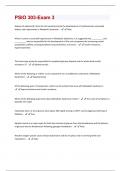Exam (elaborations)
PSIO 303-Exam 3 Questions With Correct Solutions, Already Passed!!
- Course
- Institution
Release of adiponectin from fat cells would promote the development of cardiovascular associated defects and impairments in Metabolic Syndrome. - False When it comes to essential hypertension in Metabolic Syndrome, it is suggested that __________ and __________ may be responsible for the develop...
[Show more]



